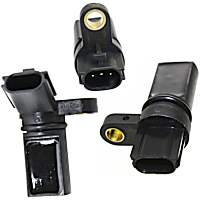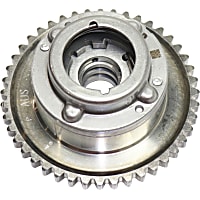Diagnostic trouble code (DTC) P0014 is a generic powertrain code that can apply to all types of vehicles. Code P0014 is only found on vehicles that have variable valve timing (VVT).
What Does the P0014 Code Mean?
OBD code P0014 stands for Camshaft Position B – Timing Over-Advanced or System Performance (Bank 1). It indicates that your car’s computer has detected a difference in the desired camshaft position angle and the actual camshaft position angle.
As for the ‘B’ part of the code, it indicates the affected camshaft. In a Dual Overhead Cam (DOHC) engine, it is the exhaust camshaft. In V6 or V8 engines, it is the exhaust cam for bank 1, the cylinder head with number one cylinder.
Bank 1 refers to the side of the engine that houses the number one cylinder (only applies to engines with a V or boxer configuration).
What are the Possible Causes of the P0014 Code?

There are a few possible reasons why your car is getting a P0014. To determine the exact cause, see our diagnosis section below.
Code P0014 can be triggered by one or more of the following issues:
- A low engine oil level or contaminated oil (VERY common)
- A faulty oil control solenoid
- A failed camshaft actuator (aka phaser)
- Damaged timing components, such as a stretched chain or damaged guide
- Circuit issues (e.g., damaged wiring, loose connections)
- Problems with the PCM or camshaft position sensor
What are the Common Symptoms of the P0014 Code?
When code P0014 is set, you will also note one or more of the following symptoms:
- Illuminated check engine light
- Hard starting
- Stalling
- Rough idle
- Increased fuel consumption and poorer fuel economy
- Engine misfire
- Rattling noise from the engine
How Serious of a Problem is a Bad Camshaft Position Sensor?
A faulty camshaft position sensor can greatly impact your vehicle’s drivability. In some cases, leaving this problem unaddressed can even render the vehicle undrivable.
The camshaft position sensor is responsible for monitoring the speed and position of the camshafts, which are responsible for regulating injector pulse and ignition timing.
Simply put, if the camshaft position sensor isn’t working as it should, the same goes for your engine.
How to Diagnose the P0014 Code
Because there are so many potential causes for code P0014, diagnosis can be extremely difficult. Here’s a video to give you an idea of the troubleshooting process:
Aside from checking for DTCs, conducting a thorough inspection of the sensor is another way to diagnose a P0014 code. Damaged wires and poor connections are usually indicative of a fault sensor.
How to Fix the P0014 Code
Like other OBD-II trouble codes, you won’t find a “magic bullet” fix for a P0014 code. It has different causes, which means there are various ways to repair it.
All vehicles are different, so when troubleshooting and repairing diagnostic trouble codes, make sure to consult the factory repair information.
With this in mind, there are numerous ways to fix the engine code P0014 error — some of which are simpler than others.
How to Replace Your Oil Filter
One example of a simple fix includes changing the oil filter of your vehicle, and you can do it in your garage or with the help of an expert. If you’re keen on learning how to replace this part of your vehicle by yourself, follow these simple steps.
- Park your vehicle on a flat and even surface.
- Lift your vehicle with floor jacks.
- Wear protective gloves.
- Locate the drain plug of your vehicle and drain all of its oil.
- Return the drain plug after draining.
- Place an oil pan below the oil filter.
- Remove your old oil filter and let the excess oil drip into the oil pan.
- Clean the O-ring and grease it with clean oil.
- Install your new oil filter.
- Fill your vehicle with new, clean oil.
- Run your engine and inspect your vehicle for oil leaks.

If your check engine light turns on even after changing your vehicle’s oil and oil filter, there might be something wrong with the camshaft.
How to Replace Your Camshaft
Like replacing the oil filter, replacing a camshaft is a task that you can do at home or with the help of a mechanic. The difficulty of this task varies depending on the vehicle because some camshafts are easier to access than others.
- Park your vehicle on a flat, even surface away from other cars, like your garage.
- Insert the wheel chocks around your vehicle’s rear wheels.
- Lift the front of your vehicle with floor jacks underneath the body pinch welds.
- Remove the engine drive belt.
- Loosen the bolts securing your timing cover and remove it.
- Disconnect the connectors on the ignition coils and remove them.
- Remove the valve cover mounting bolts and the valve cover.
- Rotate the engine with the crankshaft pulley center bolt until they align and the timing marks match up.
- Remove your old camshaft from the engine block with a camshaft removal tool.
- Take off the old camshaft gear and replace it with your new one.
- Reassemble and reinstall the camshaft.
- Realign the timing marks so they match with your camshaft.
- Turn on the ignition and test the timing of your camshaft.
- Let your car idle and observe your vehicle’s oil pressure.
If your check engine light still comes on after replacing both the oil filter and the camshaft of your vehicle, your cam phasers might also need replacement.

Getting Your Cam Phasers Replaced
If you’re keen on learning how to fix the P0014 code by replacing your cam phasers, you might not be able to. The equipment needed for the procedure can only be found in auto repair shops.
Similarly, the techniques and know-how involved with the process require a great deal of vehicular expertise. Attempting to conduct any repairs on your own without knowing exactly what to do could do more harm than good to your vehicle.
With this in mind, your best bet would be to bring your vehicle to a mechanic and have a professional replace your cam phasers.
A Quick Note About VVT Systems
As mentioned, code P0014 can appear on vehicles with variable valve timing (VVT). In a conventional engine, valve timing is fixed. But in a VVT system, valve timing can be adjusted on demand by altering the camshaft angle. VVT technology can lead to an increase in power, improved fuel economy, or both.
Typically, each VVT-equipped camshaft has an actuator at the end that rotates the cam’s relative position. Oil control solenoids provide pressurized oil to activate the actuators.
Your car’s primary computer, which is often referred to as the powertrain control module (PCM), controls the solenoids.
It’s worth noting that different automakers refer to the VVT system, as well as the individual VVT components, by different names. Toyota, for example, calls its VVT system, Variable Valve Timing with intelligence (VVT-i); Ford calls its system Twin Independent Variable Camshaft Timing (Ti-VCT). Also, unlike most other automakers, Ford refers to camshaft actuators as camshaft “phasers.”
For an advanced, technical understanding of VVT systems, you may read our discussion here.
Where to Find a Durable Camshaft Position Sensor for Your Ride
CarParts.com makes it easy for drivers like you to find high-quality replacement parts for your daily driver, including a camshaft position sensor.
Simply enter your vehicle’s specifications into our vehicle selector to start shopping for compatible products. For a more personalized shopping experience, you may also use the search filters to find products according to your preferred brand, price range, quantity, and more.
Order now, and we’ll deliver the part you need straight to your doorstep in as fast as two business days.
Enjoy low prices when you shop from us. All our products also come with a lifetime replacement guarantee, helping you get the best value for your money. Shop now!
Products Mentioned in this Guide
Any information provided on this Website is for informational purposes only and is not intended to replace consultation with a professional mechanic. The accuracy and timeliness of the information may change from the time of publication.


 Camshaft Position Sensor
Camshaft Position Sensor
 Cam Phaser
Cam Phaser


















